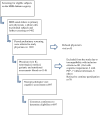Trajectories in glycemic control over time are associated with cognitive performance in elderly subjects with type 2 diabetes
- PMID: 24887092
- PMCID: PMC4041655
- DOI: 10.1371/journal.pone.0097384
Trajectories in glycemic control over time are associated with cognitive performance in elderly subjects with type 2 diabetes
Abstract
Objective: To study the relationships of long-term trajectories of glycemic control with cognitive performance in cognitively normal elderly with type 2 diabetes (T2D).
Methods: Subjects (n = 835) pertain to a diabetes registry (DR) established in 1998 with an average of 18 HbA1c measurements per subject, permitting identification of distinctive trajectory groups of HbA1c and examining their association with cognitive function in five domains: episodic memory, semantic categorization, attention/working memory, executive function, and overall cognition. Analyses of covariance compared cognitive function among the trajectory groups adjusting for sociodemographic, cardiovascular, diabetes-related covariates and depression.
Results: Subjects averaged 72.8 years of age. Six trajectories of HbA1c were identified, characterized by HbA1c level at entry into the DR (Higher/Lower), and trend over time (Stable/Decreasing/Increasing). Both groups with a trajectory of decreasing HbA1c levels had high HbA1c levels at entry into the DR (9.2%, 10.7%), and high, though decreasing, HbA1c levels over time. They had the worst cognitive performance, particularly in overall cognition (p<0.02) and semantic categorization (p<0.01), followed by that of subjects whose HbA1c at entry into the DR was relatively high (7.2%, 7.8%) and increased over time. Subjects with stable HbA1c over time had the lowest HbA1c levels at entry (6.0%, 6.8%) and performed best in cognitive tests.
Conclusion: Glycemic control trajectories, which better reflect chronicity of T2D than a single HbA1c measurement, predict cognitive performance. A trajectory of stable HbA1c levels over time is associated with better cognitive function.
Conflict of interest statement
Figures
Similar articles
-
The ApoE4 genotype modifies the relationship of long-term glycemic control with cognitive functioning in elderly with type 2 diabetes.Eur Neuropsychopharmacol. 2014 Aug;24(8):1303-8. doi: 10.1016/j.euroneuro.2014.05.001. Epub 2014 May 14. Eur Neuropsychopharmacol. 2014. PMID: 24875283 Free PMC article.
-
The association of duration of type 2 diabetes with cognitive performance is modulated by long-term glycemic control.Am J Geriatr Psychiatry. 2014 Oct;22(10):1055-9. doi: 10.1016/j.jagp.2014.01.010. Epub 2014 Jan 23. Am J Geriatr Psychiatry. 2014. PMID: 24534521 Free PMC article.
-
Glycemic control, inflammation, and cognitive function in older patients with type 2 diabetes.Int J Geriatr Psychiatry. 2015 Oct;30(10):1093-100. doi: 10.1002/gps.4267. Epub 2015 Feb 20. Int J Geriatr Psychiatry. 2015. PMID: 25703191 Free PMC article.
-
The association between trajectories of risk factors and risk of cardiovascular disease or mortality among patients with diabetes or hypertension: A systematic review.PLoS One. 2022 Jan 27;17(1):e0262885. doi: 10.1371/journal.pone.0262885. eCollection 2022. PLoS One. 2022. PMID: 35085329 Free PMC article.
-
Longitudinal trends in HbA1c patterns and association with outcomes: A systematic review.Diabetes Metab Res Rev. 2018 Sep;34(6):e3015. doi: 10.1002/dmrr.3015. Epub 2018 May 22. Diabetes Metab Res Rev. 2018. PMID: 29663623 Free PMC article.
Cited by
-
Diabetes-Related Topics in an Online Forum for Caregivers of Individuals Living With Alzheimer Disease and Related Dementias: Qualitative Inquiry.J Med Internet Res. 2020 Jul 6;22(7):e17851. doi: 10.2196/17851. J Med Internet Res. 2020. PMID: 32628119 Free PMC article.
-
Metabolic and Immune System Dysregulation: Unraveling the Connections between Alzheimer's Disease, Diabetes, Inflammatory Bowel Diseases, and Rheumatoid Arthritis.J Clin Med. 2024 Aug 26;13(17):5057. doi: 10.3390/jcm13175057. J Clin Med. 2024. PMID: 39274269 Free PMC article. Review.
-
Data-driven long-term glycaemic control trajectories and their associated health and economic outcomes in Finnish patients with incident type 2 diabetes.PLoS One. 2022 Jun 1;17(6):e0269245. doi: 10.1371/journal.pone.0269245. eCollection 2022. PLoS One. 2022. PMID: 35648780 Free PMC article.
-
Randomized Clinical Trial Examining the Impact of Lactobacillus rhamnosus GG Probiotic Supplementation on Cognitive Functioning in Middle-aged and Older Adults.Neuropsychiatr Dis Treat. 2020 Nov 13;16:2765-2777. doi: 10.2147/NDT.S270035. eCollection 2020. Neuropsychiatr Dis Treat. 2020. PMID: 33223831 Free PMC article.
-
The Relationship Between Glucose Control and Cognitive Function in People With Diabetes After a Lacunar Stroke.J Clin Endocrinol Metab. 2021 Mar 25;106(4):e1521-e1528. doi: 10.1210/clinem/dgab022. J Clin Endocrinol Metab. 2021. PMID: 33481011 Free PMC article.
References
-
- Ahtiluoto S, Polvikoski T, Peltonen M, Solomon A, Tuomilehto J, et al. (2010) Diabetes, Alzheimer disease, and vascular dementia: a population-based neuropathologic study. Neurology 75: 1195–1202. - PubMed
-
- Schnaider Beeri M, Goldbourt U, Silverman JM, Noy S, Schmeidler J, et al. (2004) Diabetes mellitus in midlife and the risk of dementia three decades later. Neurology 63: 1902–1907. - PubMed
-
- Mokini Z, Chiarelli F (2006) The molecular basis of diabetic microangiopathy. Pediatr Endocrinol Rev 4: 138–152. - PubMed
-
- Milicevic Z, Raz I, Beattie SD, Campaigne BN, Sarwat S, et al. (2008) Natural history of cardiovascular disease in patients with diabetes: role of hyperglycemia. Diabetes Care 31 Suppl 2S155–160. - PubMed
Publication types
MeSH terms
Substances
Grants and funding
LinkOut - more resources
Full Text Sources
Other Literature Sources
Medical



